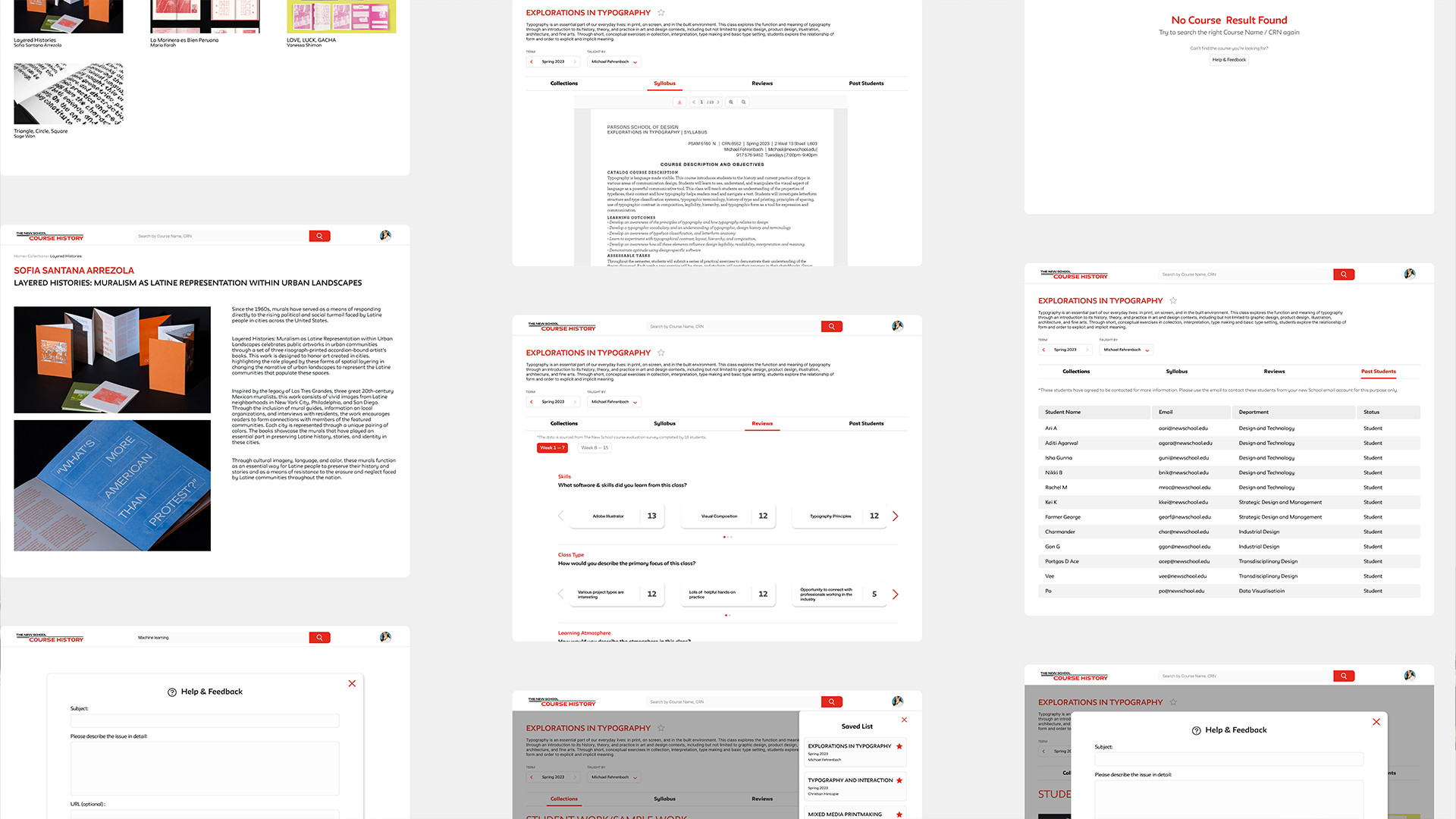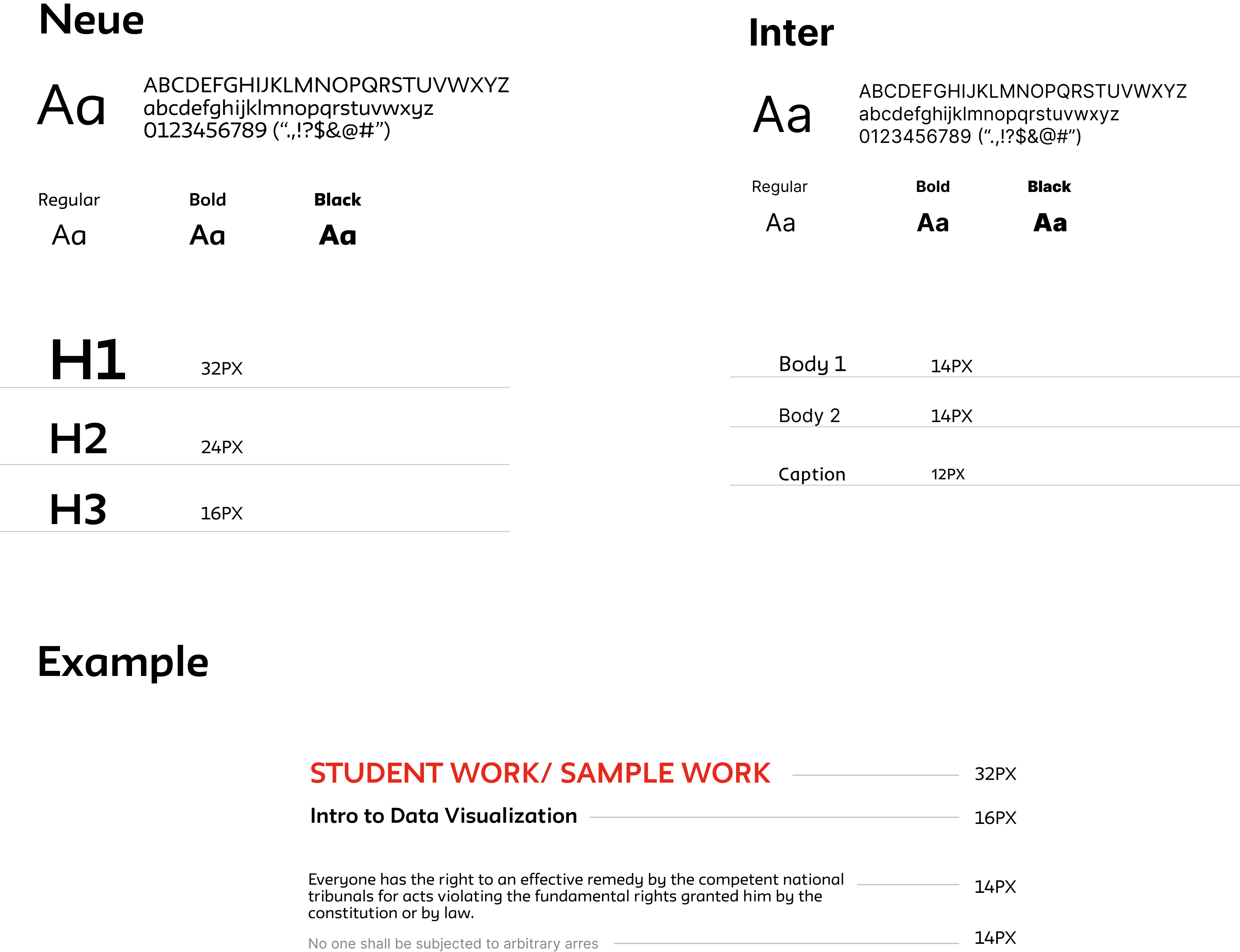
An informative platform for course registration
A user-friendly platform that optimize the course selection process experience by providing students with multiple aspects, timely and accurate information in one convenient location
I redesigned the whole scope of design
Team member: Anisha Mukherjee, Sej Sanghvi
Students at The New School face challenges in making informed course selections due to fragmented and incomplete information in the course registration system. While the course catalog serves as the primary resource, its lack of clarity and comprehensive details hinders students' ability to navigate their options effectively.
✴The New School Course CatalogA centralized platform that streamlines course information access, simplifying the search process and empowering students to make confident course selection decisions.
Our design centralizes 4 key course details for smoother access and a comprehensive understanding .
Past Students' Work: See course outcomes and examples.
Syllabus: Get a clear view of course structure and workload.
Course Reviews: Honest insights on teaching quality and atmosphere.
Peer Connections: Connect with past students for advice and extra info.
View course details from the past 3 years.
Explore other courses without navigating back to the main catalog.
Structured review framework focuses on course content through four key aspects: Skills, Class Type, Atmosphere, and Need more
Community voting surfaces valuable insights without relying on numerical ratings or subjective judgments
"Need More" section enables continuous course improvement and information discovery
We conducted a survey to identify the most common methods and channels Parsons students currently use to gather information about classes before registering and what aspects they value most for course selection.

From the survey results, we found out:
Skills development & Class format are most valued
Syllabus & past students feedback is really helpful to them to learn about the course
Decentralized Information Creates Access Barriers
Course information suffers from an inverse relationship between accessibility and value: the most insightful information is hardest to access, while readily available sources lack meaningful detail.
Our team interviewed with 5 students from different year and major to get further understanding about the course registration process and system

Decentralized Information
Struggle to make enrollment decisions due to course information being scattered across official catalogs, word-of-mouth sources, and social platforms
Facing uncertainty, Limited Understanding Into Course Realities
Limited understanding of teaching methods, grading styles, and expected outcomes causes anxiety and frustration
Limited Access to Resources
Key resources, such as previous course materials, and peer feedback, are often unavailable or difficult to find
A more relaible and easy acesse information gathering channel
Past students work and syllabus are more direct and convincible to them to make decision comparing with reviews
Past students work
“While prioritizing student needs, it's also necessary to involve faculty as key stakeholders in the improvement process.”
Our team interviewed with 2 faculties to understand the current course evaluation system and teachers’ views on course evaluation results

Powerless and less actionable against negative reviews
Faculty feel helpless when faced with negative feedback, as their inability to respond or address these comments directly impacts their professional reputation.
Feedback without direction
Non-specific feedback from course evaluation is helpful for making improvements to their teaching methods or class structure
Neutral and protect professor’s reputation for reviews
Past students work and syllabus are more direct and convincible to them to make decision comparing with reviews
Past students work


We analyzed current market platform for providing course information and evaluate them through 4 aspects


The interface and information hierarchy of on campus is clearer and accessible and no ads.


The third party cover lots of school and can’t provide specific school and course / professor’s review, not insightful enough


The review on the third party platform lack of verify and easy to make negative and fake information


Traditional rating-based review systems offer limited course insights and overlook faculty perspectives, creating an incomplete picture of course value.
After the analyzed all the research results, our team created a students key experience map to find possible intervention stageI to optimize the course registration experience

Information Gathering step is the stage most needs to be improved
Students face frustration when gathering course information, as details are scattered across official catalogs and unofficial sources, leading to inconsistent and vague course descriptions

Not just course reviews
But a comprehensive hub for course information
Provide neutral and informative resources for students to make their own decisions
Research insights led to organizing course information into 4 key aspects that address students' critical information needs:

Skills & Career prospects
Class type

Class structure & Workload
Class type

Skills & Class type
Teaching quality

Career prospects
Connection
Through iterative wireframing, we refined the information architecture and explored various approaches to navigation and course review displays.
Continuous user testing validated our concepts and informed improvements to create an intuitive search and review experience.



We did A/B testing to understand the better way of clearer information and find the course information easier

4 key aspects organize information within each course pag
Users can seamlessly search for other courses without leaving the current page
Save function: Save and organize potential courses while planning their registration
Course brief
A feedback system that moves beyond ratings to deliver constructive course insights through structured community perspectives, highlighting positive experiences to guide informed decisions.
No negative influence on faculty
Students can get the sense from the number
After user testing, the following constructive feedback

Less interactive steps

This display format is not eligible enough and make user overwhelmed



Reduce the amount of text infromation when user see at one time

Enables students to bookmark and track courses of interest, simplifying the selection process
Students can report missing details or outdated information to help keep the database current and accurate




